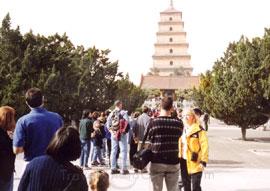
The Big Goose Pagoda is situated in the Da Ci'en Temple, four kilometers away from the center of the city. It is one of the city's most distinctive and outstanding landmarks, possibly the most beautiful building left in Xian today.
Known as the best-preserved Buddhist temple complex, the Da Ci'en Temple was initially built in 589, during the Sui Dynasty (581-618). At that time, it was named as Wulou Temple. Later in AD 647 of the Tang Dynasty, Li Zhi (who became Emperor Tang Gaozong in AD 649) ordered to rebuild this temple in memory of his late mother, Empress Wende. The temple subsequently gained its present name "Da Ci'en Temple". Within the temple, there is a small bell tower from which a bell, which was used for telling time to the monks in ancient times, hangs. Daxiongbaodian is the main hall of the temple.
In AD 652, the Big Goose Pagoda was built to store the sutras and the figurines of Buddha, which were brought from India by a famous Buddhist translator and traveler Tang Sanzang, also known by his Buddhist name as Xuanzang. At the age of 28, he set off to India to study the sutra and then brought back most of the scriptures to Chang'an, present Xian city. Altogether, he spent 17 years for a round trip and experienced many hardships. Upon his return he wrote a book entitled "Journey to the West", recording the customs of different places he visited and his experiences. Subsequently the great novelist of the Ming Dynasty Wu Cheng'en, collected the materials handed down and wrote a novel titled "Pilgrimage to the West" which later became one of four greatest novels in China. As a result, the Television Series about this story was made and became world-renowned. In memory of Xuanzang, his statue is placed in front of the Da Ci'en Temple.
During the early days, the pagoda boasted a brick structure of five storeys and about 60 meters (197 feet) high. Between AD 701 and AD 704, at the end of the reign of Empress Wu Zetian, five more storeys were added to the original pagoda. Damage by the war reduced it to seven storeys, to what it is today. With a height of 64 meters (210 miles), the pagoda occupies a base 25 meters by 25 meters (82 feet) square. The Big Goose Pagoda is a brick-tower architecture, sturdy and simple. Walls and doors are carved with vivid and exquisite figures of Buddha, reflecting the profundity in the paintings f the Tang Dynasty.
But why was this pagoda called the Big Goose Pagoda (Dayanta)?
According to historical records, the monks living in the Da Ci'en Temple had no meat to eat. They longed much for it so one of the monks started to pray to the Gods to bless them. At that very moment, a group of wild geese flew over the temple. Their heads dropped to the ground and they died. The monks were all surprised and thought it was the result of the Buddhist spirit so they decided not to eat meat forever. A pagoda was ordered to be built in this place, hence the name "Big Goose Pagoda".
|

